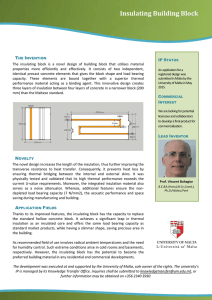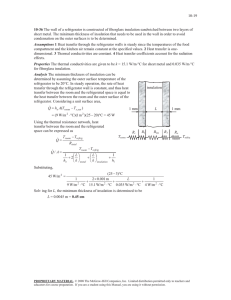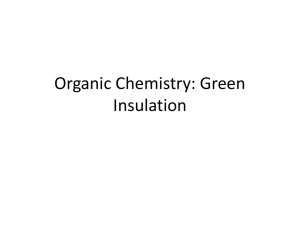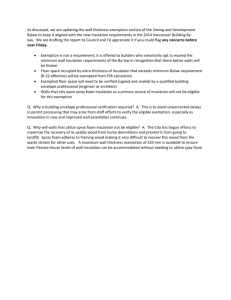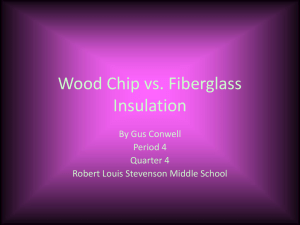Research Journal of Applied Sciences, Engineering and Technology 1(3): 94-97,... ISSN: 2040-74-67 © M axwell Scientific Organization, 2009
advertisement
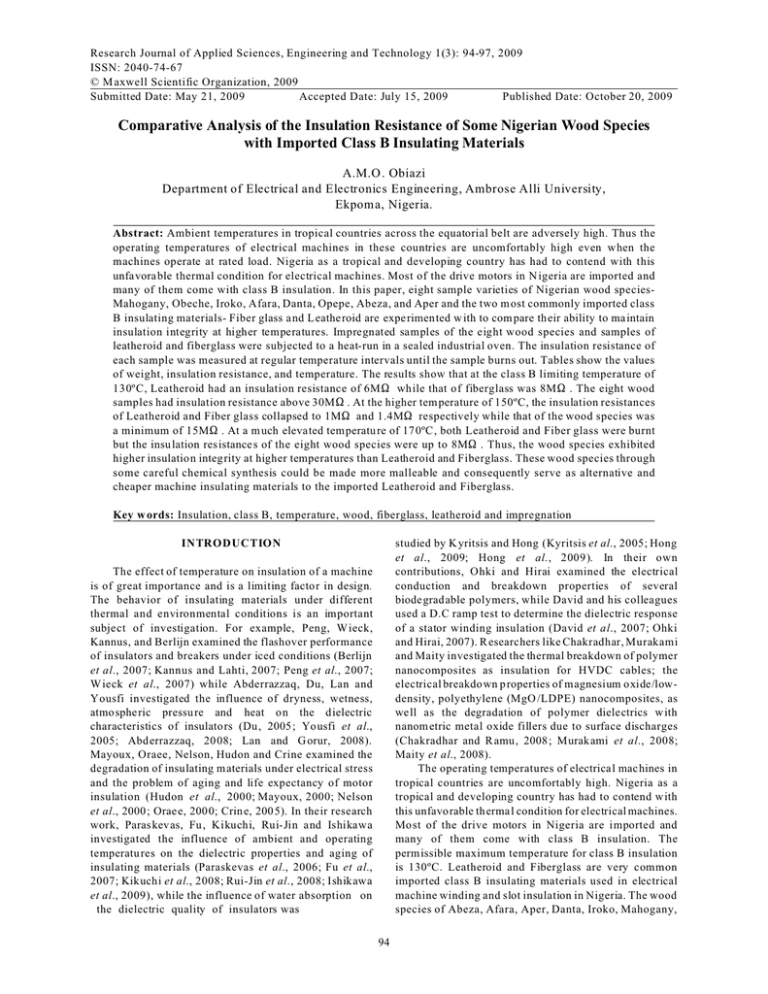
Research Journal of Applied Sciences, Engineering and Technology 1(3): 94-97, 2009 ISSN: 2040-74-67 © M axwell Scientific Organization, 2009 Submitted Date: May 21, 2009 Accepted Date: July 15, 2009 Published Date: October 20, 2009 Comparative Analysis of the Insulation Resistance of Some Nigerian Wood Species with Imported Class B Insulating Materials A.M.O . Obiazi Department of Electrical and Electronics Engineering, Ambrose Alli University, Ekpom a, Nigeria. Abstract: Ambient temperatures in tropical countries across the equatorial belt are adversely high. Thus the operating temperatures of electrical machines in these countries are uncomfortably high even when the machines operate at rated load. Nigeria as a tropical and developing country has had to contend with this unfavorable thermal condition for electrical machines. Most of the drive motors in N igeria are imported and many of them come with class B insulation. In this paper, eight sample varieties of Nigerian wood speciesMahogany, Obeche, Iroko, Afara, Danta, Opepe, Abeza, and Aper and the two m ost commonly imported class B insulating materials- Fiber glass and Leatheroid are expe rimen ted w ith to com pare their ability to maintain insulation integrity at higher temperatures. Impregnated samples of the eight wood species and samples of leatheroid and fiberglass were subjected to a heat-run in a sealed industrial oven. The insulation resistance of each sample was measured at regular temperature intervals until the sample burns out. Tables show the values of weight, insulation resistance, and temperature. The results show that at the class B limiting temperature of 130ºC, Leatheroid had an insulation resistance of 6MS while that of fiberglass was 8MS . The eight wood samples had insulation resistance above 30MS . At the higher tem perature of 150ºC, the insulation resistances of Leatheroid and Fiber glass collapsed to 1MS and 1.4MS respectively while that of the wood species was a minimum of 15MS . At a m uch elevated tem peratu re of 17 0ºC, both Leatheroid and Fiber glass were burnt but the insu lation resistance s of the eight wood species were up to 8MS . Thus, the wood species exhibited higher insulation integrity at higher temperatures than Leatheroid and Fiberglass. These wood species through some careful chemical synthesis could be made more malleable and consequently serve as alternative and cheaper machine insulating materials to the imported Leatheroid and Fiberglass. Key w ords: Insulation, class B, temperature, wood, fiberglass, leatheroid and impregnation studied by K yritsis and Hong (Kyritsis et al., 2005; Hong et al., 2009; Hong et al., 2009). In their own contributions, Ohki and Hirai examined the electrical conduction and breakdown properties of several biode gradable polymers, while David and his colleagues used a D.C ramp test to determine the dielectric response of a stator winding insulation (David et al., 2007; Ohki and Hirai, 2007). R esearchers like Chakradhar, Murakami and Maity investigated the thermal breakdown of polymer nanocomposites as insulation for HVDC cables; the electrical breakdo wn p roperties of magnesium oxide/lowdensity, polyethylene (MgO /LDPE) nanocomposites, as well as the degradation of polymer dielectrics w ith nanom etric metal oxide fillers due to surface discharges (Chakradhar and R amu , 2008 ; Murakami et al., 2008; Maity et al., 2008). The operating temperatures of electrical machines in tropical countries are uncomfortably high. Nigeria as a tropical and developing country has had to contend with this unfavorable therma l condition for electrical machines. Mo st of the drive motors in Nigeria are imported and many of them come with class B insulation. The perm issible maximum temperature for class B insulation is 130ºC. Leatheroid and Fiberglass are very common imported class B insulating materials used in electrical machine winding and slot insulation in Nigeria. The wood species of Abeza, Afara, Aper, Danta, Iroko, Mahogany, INTRODUCTION The effect of temperature on insulation of a machine is of great importance and is a limiting factor in design. The behavior of insulating materials under different thermal and environmental conditions is an important subject of investigation. For example, Peng, W ieck, Kannus, and Berlijn examined the flashover performance of insulators and breakers under iced conditions (Berlijn et al., 2007; Kannus and Lahti, 2007; Peng et al., 2007; W ieck et al., 2007) while Abderrazzaq, Du, Lan and Yousfi investigated the influence of dryness, wetness, atmosphe ric pressu re and heat on the dielectric characteristics of insulato rs (Du , 2005 ; Yousfi et al., 2005; Abd errazzaq, 20 08; Lan and G orur, 2008). Mayoux, Oraee, Nelson, Hudon and Crine examined the degradation of insulating m aterials under electrical stress and the problem of aging and life expectancy of motor insulation (Hudon et al., 2000; Mayoux, 2000; Nelson et al., 2000 ; Orae e, 200 0; Crin e, 200 5). In their research work, Paraskevas, Fu, Kikuchi, Rui-Jin and Ishikawa investigated the influence of ambient and operating temperatu res on the dielectric properties and aging of insulating materials (Paraskevas et al., 2006; Fu et al., 2007; Kikuchi et al., 2008; Rui-Jin et al., 2008; Ishikawa et al., 2009), while the influence of water absorption on the dielectric quality of insulators was 94 Res. J. Appl. Sci. Eng. Teachnol., 1(3): 94-97, 2009 Table 1: Initial parameters of samples Material Weight of Samples (g) Insulation resistance(M S ) Before Immediately After drying varnishing after varnishing Abeza 11.918 13.261 12.262 200 Afara 15.277 18.127 16.632 200 Aper 24.293 26.204 25.041 200 Da nta 14.623 16.224 15.871 200 Iroko 14.649 15.000 14.710 200 Mahogany 16.523 18.830 17.760 200 Obeche 28.367 31.276 30.176 200 Opepe 17.989 19.680 18.798 200 Fiberglass 1.417 200 Leath eroid 2.166 200 Obeche, and Opepe are abundantly available in Nigeria. The research experimented with these wood species as well as Leathero id and Fiberg lass to comp are their ability to maintain insulation integrity at higher temperatures. The research also evaluated if these wood species can serve as viab le alternative and cheaper machine insulating materials to the imported Leatheroid and Fiberglass. MATERIALS AND METHODS The eight w ood species used in the exp erimental w ork were; C Abeza C Afara C Aper C Danta C Iroko C Mahogany C Obeche C Opepe The two imported class B insulating materials were; C Fiberglass C Leatheroid Tab le 2: Heat Run and Insulati on R esistanc e M easure men t of Sample M aterials (M ) Material 30ºC 50ºC 70ºC 90ºC 110ºC 130 0C 150ºC 170ºC Abeza 200 200 180 150 80 40 15 8 Afara 200 180 150 110 75 30 15 8 Aper 200 200 180 150 100 50 20 9 Da nta 200 200 180 140 90 40 18 9 Iroko 200 200 180 150 100 50 20 9 Mahogany 200 180 150 110 80 40 15 8 Obeche 200 200 150 110 75 40 18 8 Opepe 200 200 150 130 80 40 18 9 Fiberglass 200 180 100 60 20 8 1.4 Leath eroid 200 180 100 50 20 6 1 - the oven temperature was raised to 150ºC, the insulation resistances of Leathero id and Fiberg lass collapsed to 1MS and 1.4M S respectively. But the insulation resistance of the wood samples was a minimum of 15MS . In fact, Aper and Iroko each had an interesting figure of 20MS . At an elev ated oven temperature of 170 ºC, both Leatheroid and Fiberglass w ere burnt. Of the eight wood species, four (Abeza, Afara, Mahogany, Obeche) had an insulation resistance of 8MS while Aper, Danta, Iroko and Opepe had an insulation resistance of 9MS . Thus, the wood samples exhibited higher insulation resistances at higher temperatures than Leatheroid and Fiberglass, the imported class B insulating materials. Preparation of the Sam ples: Each of the eight wood s p e ci e s wa s cut into a sam ple m easu rin g 10cm×5cm×0.5cm. They were impregnated by immersing in a hot insulating varnish for twenty hours and then slow ly dried for three days. Both Leatheroid and Fiberglass were cut into samples measuring 10cm×5cm. But the thickness of each sample was maintained as manufactured in order not to alter the material integrity of the sample. The weight of the samp les before impregnation, immediately after im pregnation, and after drying as well as the initial insulation resistance (at room temperature) of each sample material are show n in Table 1 CONCLUSION The experiments showed that the impregnated samples of the eight wood species-Abeza, Afara, A per, Danta, Iroko, Mahogany, Obeche, and Opepe exhibited higher insulation integrity at higher temperature than Leatheroid and Fiberglass, the imported class B insulating materials. These wood species through some careful chemical synthesis could be made malleable and consequ ently serve as alternative and cheaper machine insulating materials to the imported Leatheroid and Fiberglass. Hea t- Run: Each sample of the eight wood species as well as samples pf Leatheroid and Fiberglass w ere subjected to heat run in a well-lagged industrial oven. The insulation resistances of the samples were measured at regular temperature intervals of 20ºC until the given sample burns out. Table 2 shows the insulation resistance measurement of the samples during the heat-run. RESULTS AND DISCUSSION Table 2 presents some fascinating results. Fibreglass and Leatheroid are the two most commonly imported class B insulating materials for electrical machine winding and slot insulation in Nigeria. At the class B limiting temperature of 130ºC, Leatheroid had an insulation resistance of 6MS while that of fiberglass is 8MS . The insulation resistance of impregnated samples of the eight wood species at this temperature was a minimum of 30MS . Aper and Iroko each had an insulation resistance of 50MS at this temperature. When REFERENCES Abderrazzaq, M.H ., 2008. Ch aracterizing the internal strain in composite insulation under dry and wet conditions, Institute of Electrical and Electronics Engine ers [IEEE], Transactions on Dielectrics and Electrical Insulation [TDEI], 15(5): 1353-1359. Accession Number=10291011, DOI= 10.1109/TD EI.2008.4656244. 95 Res. J. Appl. Sci. Eng. Teachnol., 1(3): 94-97, 2009 Berlijn, S.M., I. Gutman, K.A. Halsan, M. Eilertsten and I.Y.H. Gu, 2007. Laboratory tests and web-based surveillance to determine the ice-and snow performance of insulators, ibid, Dec., 14(6): 1373-1380. Accession Number = 9900581, DOI=10.1109/TDEI.2007.4401219. Chakradhar, R.C. and T.S. Ramu, 2008. Polymer nanocomposites as insulation for HV DC cablesInvestigations on the thermal breakdown, ibid, Feb., 15(1): 221-227. Accession Number = 9901381, DOI=10.1109/T-DEI.2008.4446754. Crine, J.P., 2005. Influence of electromechanical stress on electrical properties of dielectric polymers, ibid, Aug., 12(4): 791-800. Accession Number = 8574903, DOI=10.1109/TDEI.2005.1511104. David, E., T, Godwin, J. Bellemare and L. Lamarre, 2007. Modeling of the dielectric response of a stator winding insulation from a DC ramp test, ibid, D ec., 14(6): 1548-1558. Accession Number = 9695239, DOI=10.1109/TDEI.2007.4401239. Du, B.X ., 2005 . Effects of atmospheric pressure on DC resistance to tracking of polymer insulating materials, ibid, Dec., 12(6): 1162-1171 . Accession Nu mber= 8691774, DOI= 10.1109/TD EI.2005.1561796. Fu, M., G. Chen, L.A. Dissado and J.C. Fothergill, 2007. Influence of thermal treatment and residues on space charge accumulation in XLPE for DC power cable application. ibid , Feb., 14(1): 53-64. A ccession N u m be r= 9 29 8 52 8 , D O I= 10.1109/TD EI.2007.302872. Hong, T.P., O. Lesaint and P. Gonon, 2009. Water absorption in a glass-mica-epoxy composite[I:Influence on electrical pro perties]. ibid, Feb., 16(1): 1-10. Accession Number = 10476235, DO =10 .1109/TD EI.2009.4784545. Hong, T.P., P. Gonon and O. Lesaint, 2009. Water absorption in a glass-mica-epoxy com posite [II:Field distribution and d iagno stic in a stator bar geom etry], ibid, Feb., 16(1): 11-16. Accession Num ber= 10479167, D OI= 10.1109/TD EI.2009.4784546. Hudon, C., N. Amyot, T. Lebey, P. Castelan and N. Kandev, 2000. Testing of low voltage motor turn insulation intended for pulse-width modulated applications, ibid, Dec., 7(6): 783-789. Accession Numbe r = 6797115, D OI= 10.1109/94.89 1989. Ishikawa, T., K. Yasuda, T. Igarashi, S. Yan abu, G. U eta and S. Okabe, 2009. Effect of temperature on the streaming electrification characteristics of silicone oil, ibid, Feb., 16(1): 273-280. Accession N umbe r= 10476260, D OI= 10.1109/TD EI.2009.4784577. Kannus, K. and K. Lahti, 2007. Laboratory investigations of the electrical performance of iced-covered insulators and a metal-oxide surge arrester, ibid, Dec., 14(6): 1357 -1372. A ccession N umbe r= 9711616, DOI=10.1109/TDEI.2007.4401218. Kikuchi, Y., T. Murata, Y. U ozumi, N . Fukumoto, M. Nagata, Y. Wakimoto, and T. Yoshimitsu, 2008. Effects of ambient humidity and temperature on partial discharge characteristics of conventional and nanocompo site enam eled m agnet wires, ibid, D ec., 15(6): 1617-1625. Accession Number =10370139, DO I=10 .1109/TD EI.2008.4712665. Kyritsis, A., M . Siakantari, A. Vassilikou -Dova, P. P issis and P. Varotsos, 2000. Dielectric and electrical properties of polycrystalline rocks at various hydration levels, ibid, Au g., 7(4): 493-497. Ac cessio n Number = 6710874, D O I= 10.1109/94.86 8067. Lan, L. and R. Gorur, 2008. Computation of ac wet flashover voltage of ceramic and comp osite insulators, ibid, Oc t., 15(5): 1346-1352. A c c e s s i o n N u m b e r = 1 0 3 1 1 36 8 , D O I= 10.1109/TDEI.2008.4656243. Maity, P., S. Basu, V. Parameswaram and N. Gupta, 2008. Degradation of polymer dielectrics w ith nanome tric metal-oxide fillers due to surface discharges, ibid, Feb., 15(1): 52-62. Accession Num ber = 97 685 35, D OI= 10.1 109 /TDEI.2008.4446736. Mayoux, C., 2000. Degrad ation of insulating ma terials under electrical stress, ibid, Oct., 7(5): 590-601. Accession Nu mbe r = 67 565 23, D O I= 10.1109/TD EI.2000.879355. Murakami, Y., M. Nemoto, S. Okuzumi, S. Masuda, M. Nagao, N. Hozumi and Y. Sekiguchi, 2008. DC Conduction and Electrical Breakdown of MgO/LDPE Nanoco mposites, IEEE Transactions on Dielectrics and Electrical Insulation, Feb., 15(1): 33-39. Nelson, J.K., S. Azizi-Ghannad and Li Hong, 2000. Theory and application of dynamic aging for life estimation in machine insulation, ibid, Dec., 7(6): 773-782. Acce s s ion N umbe r = 679 7114, DOI=10.1109/94.891988. Ohki, Y. and N. Hirai, 2007. Electrical conduction and breakdown properties of several biodegradable polymers, ibid, Dec., 14(6): 1559-1566. Accession N u m b e r = 9 7 3 6 0 8 3 , D O I = 10.1109/TDEI.2007.4401240. Oraee, H., 2000. A quantitative approach to estimate the life expe ctancy of m otor insulation systems, ibid, Dec., 7(6): 790-796. Accession Number = 6807375, DOI=10.1109/94.891990. Paraskevas, C.D., P. Vassiliou and C.T. Dervos, 2006. Temperature depe ndent dielec tric spectroscopy in frequency dom ain of high-voltage transformer o ils compared to physicochemical results, ibid, June, 13(3): 539-546. Accession Number = 9028348, DOI=10.1109/TDEI.2006.1657966. Peng, L., F. Jianbin, L. Wufeng, S. Zhiyi and Z. Jun, 2007. Flashover performance of HVDC iced insulator strings, ibid, Dec., 14(6): 1334-1338. A c c e s s i o n N u m b e r = 9 6 9 5 23 8 , D O I = 10.1109/TDEI.2007.4401215. 96 Res. J. Appl. Sci. Eng. Teachnol., 1(3): 94-97, 2009 Rui-Jin, L., T. Chao, Y. Li-Jun and S. Grzybowski, 2008. Thermal aging microscale analysis of power transformer pressboard, ibid, Oct., 15(5): 1281-1287. A c c e s s i o n N u m be r = 1 03 1 13 6 6, D O I = 10.1109/TDEI.2008.4656235. W ieck, H., I. Gutman and T. Ohnstad, 2007. Investigation of flashover performance of snow-covered breakers, ibid, Dec., 14(6): 1339-1346. Ac cession N umbe r = 9711614, DOI=10.1109/TDEI.2007.4401216. Obiazi, A..M ..O., 2002. Energy Losses and Measurement in Electric Drives, PON Publishers, A gbor, Nigeria, pp: 77-92. Yousfi, M., P. Robin-Jouan, and Z. Kanzari, 2005. Breakdown electric field calculations of hot SF6 for high voltage circuit breaker applications, ibid, Dec., 12(6): 1192 -1200. Accession Number = 8691777, DO I=10 .1109/TD EI.2005.1561799. 97

